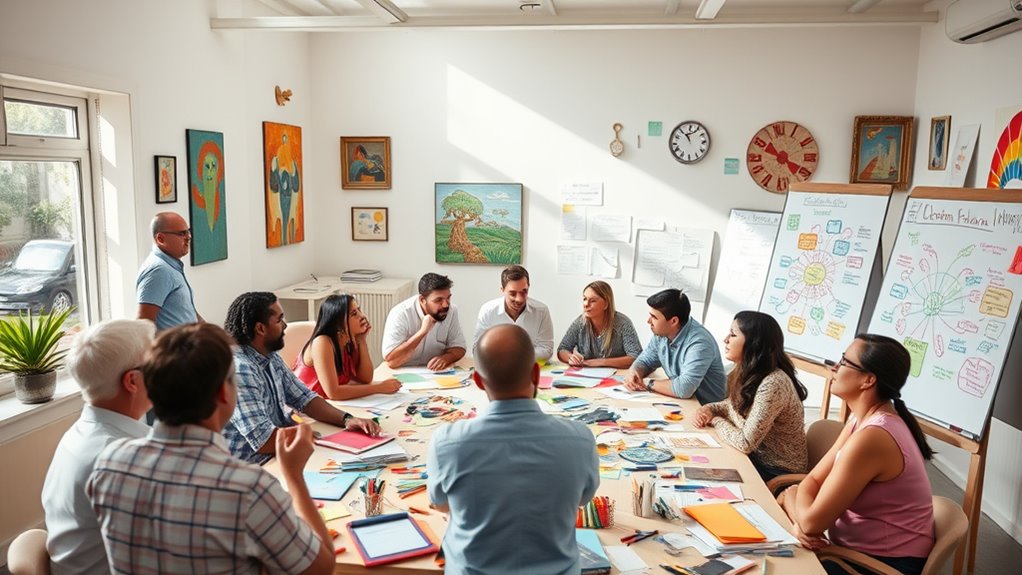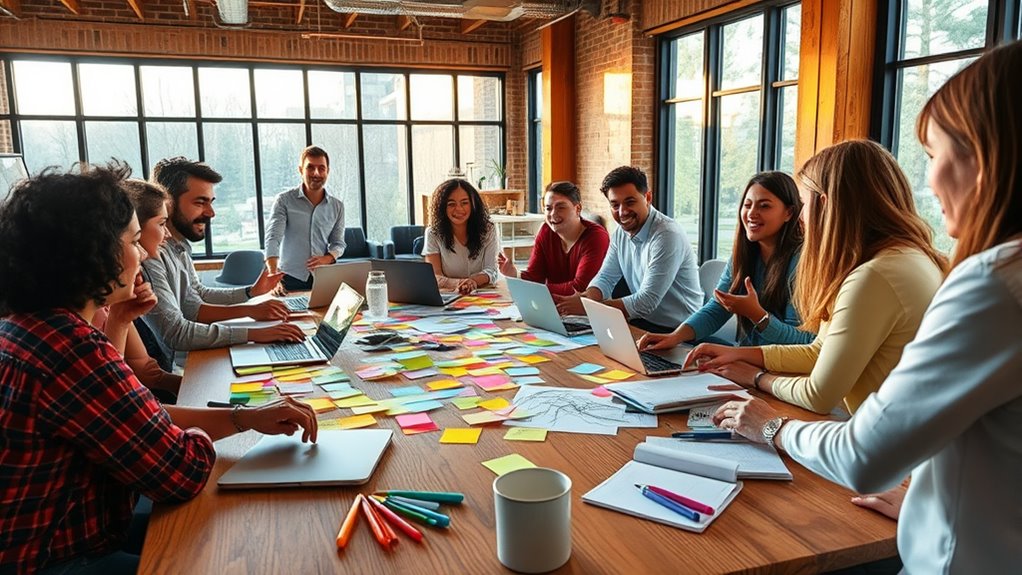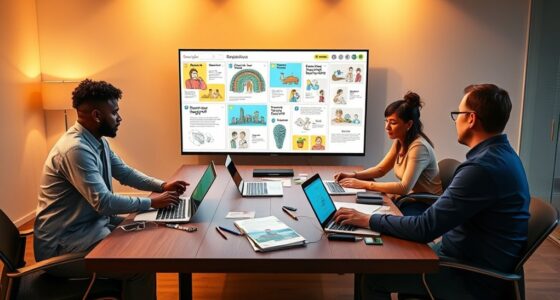Collaborative workshops are great for boosting your team’s creativity and innovation. They bring people together to solve problems, generate ideas, and build skills through active participation. You can use techniques like mind mapping, round-robin sharing, and affinity mapping to encourage diverse perspectives. Managing team dynamics and creating a positive environment help everyone feel heard and valued. Keep exploring to discover how choosing the right approach can lead to breakthrough solutions and stronger team bonds.
Key Takeaways
- Use diverse brainstorming techniques like mind mapping and brainwriting to stimulate creative ideas and open communication.
- Facilitate active participation from all team members to harness collective creativity and ensure inclusive contribution.
- Create a positive, trust-based environment that encourages sharing ideas without fear of judgment.
- Incorporate activity shifts and small group work to maintain high energy and engagement levels.
- Focus on shared purpose and collaboration outcomes to strengthen team cohesion and foster innovative solutions.

Collaborative workshops bring people together to solve problems, generate ideas, and build skills through active participation. When you facilitate these sessions, one of your main goals is to harness the collective creativity of the group. To do this effectively, you’ll want to incorporate a variety of brainstorming techniques that stimulate diverse perspectives and encourage open communication. These techniques, such as mind mapping, round-robin idea sharing, or brainwriting, serve as tools to break down mental barriers and spark innovative thinking. By creating a structured environment where everyone feels comfortable contributing, you help improve team dynamics, fostering a sense of shared purpose and trust.
Understanding team dynamics is essential in these workshops because it influences how ideas are exchanged and how conflicts are managed. When team members feel heard and valued, they’re more likely to participate actively, leading to richer discussions and more creative solutions. As a facilitator, you should pay attention to how personalities interact, ensuring that dominant voices don’t overshadow quieter participants. Encouraging balanced participation helps balance the energy within the group, making it easier to build on each other’s ideas. Recognizing the natural flow of team dynamics allows you to adapt your approach, whether that means breaking the group into smaller sub-teams or shifting activities to maximize engagement.
Pay attention to team interactions to foster participation and adapt activities for better engagement.
Incorporating different brainstorming techniques also helps to keep the energy high and prevent stagnation. For instance, rapid-fire sessions can generate a large quantity of ideas quickly, which you can later refine, while techniques like affinity mapping help organize these ideas into meaningful categories. When you understand how team members prefer to contribute, you can tailor your approach—perhaps blending silent idea generation with open discussion—to maximize participation. This adaptability not only enhances creativity but also strengthens team cohesion as members see their contributions valued. Additionally, understanding cybersecurity vulnerabilities can help teams develop more resilient solutions when addressing technical challenges.
Ultimately, the success of a collaborative workshop hinges on your ability to facilitate a positive environment where brainstorming techniques are used intentionally to foster open dialogue and collective problem-solving. By paying attention to team dynamics and encouraging diverse ways of thinking, you create a space where innovation thrives. When everyone feels empowered to share their ideas without judgment, you lay the groundwork for breakthrough solutions and a more cohesive, motivated team. This approach turns a simple workshop into a powerful tool for nurturing creativity and strengthening team bonds.
Frequently Asked Questions
How Do I Measure the Success of a Collaborative Workshop?
You can measure the success of a collaborative workshop by evaluating participant engagement and conducting outcome evaluations. Observe how actively participants contribute and interact during sessions, noting any increased enthusiasm or creativity. Afterward, evaluate the tangible results, like new ideas generated or solutions developed. Collect feedback through surveys or discussions to gauge satisfaction and learning. Combining these insights gives you a clear picture of the workshop’s effectiveness and areas for improvement.
What Are Common Challenges Faced During Team Workshops?
During team workshops, you often face challenges like groupthink pitfalls, where ideas become limited by conformity. To tackle this, you should implement engagement strategies that encourage diverse opinions and open dialogue. Managing dominant voices and ensuring everyone’s participation can be tough, but by fostering an inclusive environment and setting clear rules, you create space for creativity to flourish and prevent stagnation, leading to more effective, innovative teamwork.
How Can Virtual Workshops Foster Creativity Effectively?
You can foster creativity in virtual workshops by boosting virtual engagement through interactive activities and real-time collaboration tools. Use creative facilitation techniques like breakout rooms, visual brainstorming, and anonymous idea sharing to keep participants involved and inspired. Encouraging open communication and providing diverse perspectives helps spark innovative ideas. By maintaining energy and focus, you guarantee your virtual workshop becomes a dynamic space where teams thrive creatively despite the remote setting.
What Tools Enhance Collaboration in Remote Team Workshops?
Think of your remote workshop as a symphony, where each tool plays a crucial part. Digital whiteboards let you brainstorm and visualize ideas transparently, while breakout rooms act as mini-stages for small group collaboration. These tools encourage active participation and idea sharing, making your virtual workshop more dynamic and engaging. When used together, they create a harmonious environment that sparks creativity and strengthens team bonds.
How Do I Tailor Workshops for Diverse Team Dynamics?
To tailor workshops for diverse team dynamics, consider cultural considerations to guarantee inclusivity and respect. Engage participants by incorporating varied activities that cater to different learning styles and backgrounds, boosting their engagement. Actively listen to feedback, adapt your approach as needed, and foster an environment where everyone feels valued. This personalized approach enhances collaboration, sparks creativity, and helps your team work more effectively across differences.
Conclusion
Now that you’ve seen how collaborative workshops can ignite creativity, imagine what your team could accomplish next. With each session, you’ll unleash ideas you never thought possible, but the real breakthrough awaits just beyond the horizon. Are you ready to take that leap and discover the untapped potential within your team? The next great innovation could be one workshop away—if you dare to make it happen. The question is, will you?









